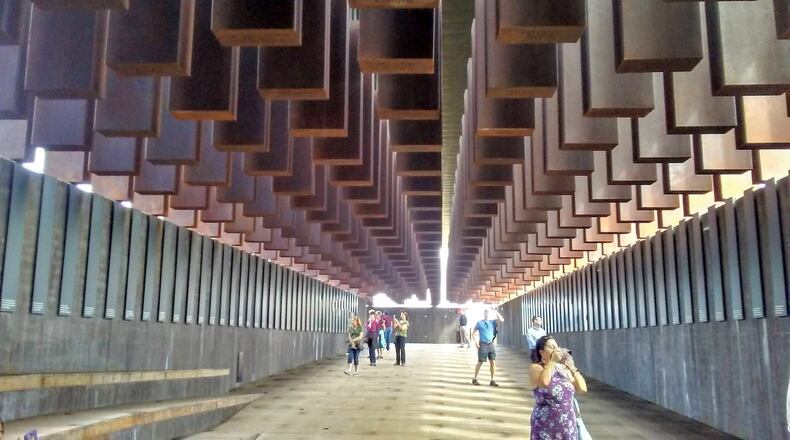Researchers from the Alabama-based Equal Justice Initiative have added thousands of names to a growing master list documenting of one of America’s worst atrocities — the lynching of black families in the decades following emancipation.
Five years ago, EJI released "Lynching in America," an exhaustive report of more than 4,000 documented cases of black men, women and children murdered by white mobs from 1877 to 1950, including 800 more killings than had previously been included in any single source. In 2017, after more research, EJI added hundreds more to the total.
In a report released Tuesday, EJI reaches back to the years immediately following the end of the Civil War, adding at least 2,000 lynchings. The report documents more than 300 acts of violence and 13 deaths in Reconstruction-era Georgia, including mass lynchings in McDuffie County in east Georgia and in the south Georgia city of Camilla. Both violent episodes were designed to terrorize African Americans and prevent them from voting.
The report, “Reconstruction in America,” shows how whites used racial violence to reassert white supremacy while stripping away the political, economic and civil gains African Americans had hoped would provide them with a brighter future for them and their children.
Bryan Stevenson, founded and executive director of the project, said cataloging lynching during Reconstruction had always been a goal, but the research took longer because the political climate following the Civil War meant that mob violence was often hidden by local politicians and white newspapers.
“It’s only after Reconstruction that black newspapers emerge (and) the political climate shifts so that white media and the white community is comfortable talking about these lynchings, even bragging about them,” Stevenson said.
For its new report, EJI researchers had to gather details of violence against the newly freed through archival records from government offices and Congressional testimony. Even so, he said the total is incomplete.
“We believe there are thousands more than will never be reported,” he said.
The violence in the report is startling. In Camilla, white residents, determined to stop two visiting black politicians from speaking at rally, fired upon black marchers, killing at least seven and wounding 30.
Camilla Councilman Corey Morgan, a 25-year-old African-American resident elected last year as the city’s youngest-ever elected official, said he first heard about the “Camilla Massacre” in 2008 when he was in middle school. He said he hopes the EJI report will restart stalled talks to formally recognize the violence with a local monument.
“We had people in the black community who died that day so we can vote,” he said. “For our brothers and sisters in the white community, this is an opportunity to recognize that.”
The newly released report comes as America grapples with the fury of black protesters fed up with institutional racism and the violence that supports it.
Angry protests erupted in Atlanta last weekend over the death of Rayshard Brooks, shot in the back as he fled an Atlanta police officer. Thousands of protesters showed up at the State Capitol Monday calling on state lawmakers to embrace fundamental changes in how police behave.
Stevenson said the violence of the dozen years following the Civil War set the stage for the next century of race relations in the South, as white “Redeemers” reasserted racial dominance, courts and prosecutors capitulated, and Congress lost the political will to cement the gains of the war into daily practice.
“If you had to do over any 12 year period in American history, this would be the period,” he said. “The whole of American history could have shifted in a radically different way.”
Yet not everyone welcomes the attention brought to atrocities committed more than 150 years ago. Shortly after the Camilla Massacre, a white mob killed a black man named Perry Jeffreys and most of his family in east Georgia to stop him from voting for Ulysses S. Grant for president.
The report places the site of the atrocity in McDuffie County. Kenneth Usry, mayor of Thomson, the county seat, said he had no comment about the report, which he had not seen.
“Sometimes we dig too far back in the past,” he said.
County Commissioner Chairman Charlie Newton called the murders “a terrible, terrible thing,” but he said they did not happen in McDuffie County, which was not created until 1870, carved from neighboring counties.
“If this group wants to get the history correct, they are talking about Warren or Columbia county,” he said.
Records from the Freedmen’s Bureau, the federal agency created after the Civil War to assist freed blacks in settling into their new lives, show the massacre of Jeffreys’ family occurred over nine days and in several locations. The records describe Jeffreys as “a good old freedman” and farmer of some means, with a crop that stood to “clear him near $1,000.”
Stevenson laughed at the response from McDuffie officials, mostly because he’s heard it before. Researchers chose the modern names of the sites because the hope is the report will prompt discussion, recognition and healing in those communities.
“Changing your name doesn’t change the history,” he said. “We want to create an opportunity for people in these communities to reckon with this history.”
The newly researched lynchings will be added to the National Memorial for Peace and Justice in Montgomery, where they will join more than 800 steel monuments, one for each county in America where a lynching took place.
About the Author
The Latest
Featured





